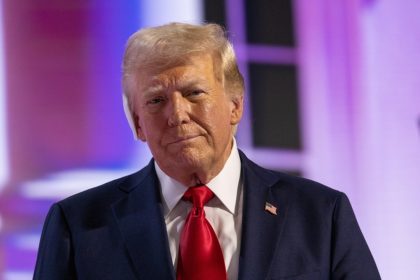That magical number cryptocurrency enthusiasts have been eyeing for months is just a breath away once again. Bitcoin is hovering tantalizingly close to the $100,000 threshold this morning, trading above $99,800 and sending ripples of excitement through digital asset markets that have weathered a rocky few months since setting all-time highs earlier this year.
After riding a roller coaster that saw prices plummet below $75,000 just last month following Trump’s controversial “Liberation Day” tariffs, Bitcoin has staged a remarkable comeback in recent weeks. This latest surge brings the cryptocurrency within striking distance of crossing the psychologically significant six-figure mark for the first time since early February—a barrier it initially conquered back in December 2024.
Let’s explore what’s driving this dramatic turnaround, why investors are suddenly optimistic again, and what this movement might signal about both cryptocurrency markets and the broader economic landscape in the wake of recent political and economic turbulence.
The presidential promises fueling market movements
The catalyst behind today’s Bitcoin surge appears directly linked to President Trump’s recent announcements about international trade negotiations. After weeks of market anxiety following his aggressive tariff policies, Trump teased a “major trade deal” with a “big” country on Truth Social yesterday, setting off speculation about potential economic relief on the horizon.
That anticipation transformed into concrete movement this morning when the president followed up with another post announcing a “full and comprehensive” agreement with the United Kingdom. While specifics remain scarce until the scheduled 10 a.m. ET press conference today, the mere promise of stabilizing international trade relations has injected fresh optimism into markets still reeling from April’s tariff-induced selloffs.
What makes this political development so impactful for Bitcoin specifically is how it addresses the very uncertainties that sent the cryptocurrency plummeting alongside traditional markets last month. Trump’s additional comment that many other deals are “in serious stages of negotiation” further amplified market hopes that the economic uncertainty that has plagued global markets might soon find resolution through bilateral agreements rather than continued trade hostilities.
The timing highlights Bitcoin’s increasingly complex relationship with geopolitical events and economic policy—no longer existing in its own isolated bubble but responding to the same forces that move traditional markets, albeit often with more dramatic price swings in both directions.
The remarkable recovery from tariff trauma
Today’s flirtation with $100,000 becomes even more impressive when viewed against Bitcoin’s recent price history. Just over a month ago, the cryptocurrency was trading below $75,000, marking a stunning decline from its January peak of more than $109,114—an all-time high reached just before Trump’s second inauguration.
This remarkable 30% rebound in approximately 30 days demonstrates cryptocurrency’s notorious volatility but also suggests something about market resilience and investor attitudes toward digital assets during economic uncertainty. Rather than abandoning crypto entirely during the April market chaos, many investors appear to have seen the dip as a buying opportunity once initial panic subsided.
The speed of recovery also reflects how sentiment in cryptocurrency markets can shift dramatically based on narrative changes. The same investors who feared economic calamity from trade wars just weeks ago now appear to be betting that international commerce will stabilize and potentially thrive under new bilateral agreements—with Bitcoin positioned as a beneficiary of renewed global economic optimism.
This whiplash-inducing reversal emphasizes why cryptocurrency remains such a challenging market for casual investors to navigate. Price movements frequently amplify underlying economic trends, creating steeper climbs and more dramatic drops than seen in traditional asset classes responding to the same news cycles.
The crypto-friendly policies that started it all
Bitcoin’s current approach to $100,000 represents the latest chapter in a story that began even before Trump retook office. The initial breakthrough beyond the six-figure threshold in December 2024 corresponded directly with Trump announcing Paul Atkins as his pick for SEC chair—a selection widely viewed as signaling a regulatory environment more favorable to cryptocurrency development and investment.
That appointment triggered the first surge toward all-time highs, reflecting how deeply regulatory considerations affect cryptocurrency valuations. Unlike traditional asset classes with centuries of established regulatory frameworks, digital assets exist in a comparatively undefined space where each political appointment and policy announcement can significantly reshape market conditions.
The subsequent January peak above $109,000 further demonstrated how aligned cryptocurrency markets had become with expectations for Trump’s second term. Many investors clearly anticipated that his administration would create conditions favorable for digital asset growth—expectations temporarily shattered by the surprise “Liberation Day” tariffs that sent markets into a temporary tailspin regardless of earlier crypto-friendly signals.
Today’s recovery suggests investors may be recalibrating their expectations once again, potentially viewing the tariff policies as a negotiating tactic rather than a permanent economic stance. The market appears to be betting that the administration’s fundamental orientation toward cryptocurrency remains positive, even if broader economic policies created temporary disruption.
The ripple effect across digital assets
Bitcoin’s resurgence isn’t happening in isolation. As the flagship cryptocurrency approaches the $100,000 milestone again, it’s pulling the broader digital asset market along with it. Ethereum has jumped an impressive 6.2%, while other major cryptocurrencies like XRP and Solana have posted gains of 3.1% and 4.2% respectively.
Even the often-volatile meme coin sector has joined the rally, with Dogecoin rising 5.8% and Shiba Inu adding 4.7%. This synchronized movement reflects Bitcoin’s continuing role as the primary market indicator for the entire cryptocurrency ecosystem, with its trends frequently amplified across smaller and more specialized tokens.
The uniform direction of these moves suggests investors view the potential trade agreements as broadly positive for the digital asset space rather than specifically beneficial to Bitcoin alone. This pattern aligns with how the April market downturn similarly affected virtually all major cryptocurrencies, regardless of their distinct technological foundations or use cases.
While cryptocurrency proponents often emphasize the unique attributes of different blockchain projects, market movements continue to demonstrate that external economic factors frequently overshadow these distinctions in the short term. Investor sentiment about macroeconomic conditions or regulatory environments typically creates market-wide movements that affect the entire digital asset sector simultaneously.
The psychological significance of round numbers
There’s nothing inherently meaningful about Bitcoin reaching exactly $100,000—no fundamental change in the technology, adoption rate, or utility happens at this specific price point. Yet round numbers hold tremendous psychological power in financial markets, often serving as both resistance levels that temporarily halt progress and celebration points that validate investment theses.
For many Bitcoin advocates, the six-figure milestone represents more than just a number. It’s validation of years-long predictions that once seemed fantastical, confirmation of cryptocurrency’s evolution from fringe experiment to legitimate asset class, and tangible evidence of the market’s maturation and resilience through multiple market cycles.
The psychological impact extends beyond current investors to the broader public and media landscape. Headlines announcing “Bitcoin Crosses $100,000” attract attention from people who might otherwise pay little attention to cryptocurrency markets, potentially drawing new participants and further reinforcing positive sentiment loops that can extend price momentum.
This psychological component helps explain why Bitcoin often experiences increased volatility around major round-number thresholds. The approach to $100,000 creates natural tension between those eager to take profits at this symbolic level and new buyers attracted by the milestone’s apparent validation of cryptocurrency’s upward trajectory.
The broader economic signals worth watching
Beyond cryptocurrency-specific considerations, Bitcoin’s recovery to near-$100,000 levels may reflect changing sentiments about the broader economy following weeks of uncertainty. The digital asset’s rebound coincides with cautious optimism in traditional markets that the worst fears about trade disruptions and economic isolation might prove overblown.
This alignment challenges earlier narratives that positioned Bitcoin as primarily a hedge against economic instability. Today’s price movement suggests that, at least in this instance, the cryptocurrency is moving more like a risk asset that benefits from economic optimism rather than a safe haven during economic turbulence.
The coming days will prove particularly revealing as details of the U.S.-U.K. agreement emerge and markets assess whether the deal represents a genuine pivot toward economic cooperation or merely a symbolic gesture without substantial impact on trade dynamics. Bitcoin’s price action following these revelations may provide insights into how investors are interpreting the actual substance behind the announcement.
While cryptocurrency remains notoriously difficult to predict, today’s approach to $100,000 contains valuable lessons about Bitcoin’s evolving relationship with traditional economic factors. Rather than existing as a truly independent alternative to the conventional financial system, Bitcoin increasingly functions as a magnifying glass that amplifies underlying economic trends—for better or worse.
Whether Bitcoin decisively breaks through the $100,000 threshold again or faces rejection at this symbolic level, today’s price action reinforces how thoroughly the digital asset has integrated with broader financial markets. The days of cryptocurrency moving in complete isolation from world events have clearly ended, replaced by complex interrelationships that connect digital assets to the same forces driving traditional markets—just with the volume turned up.

















